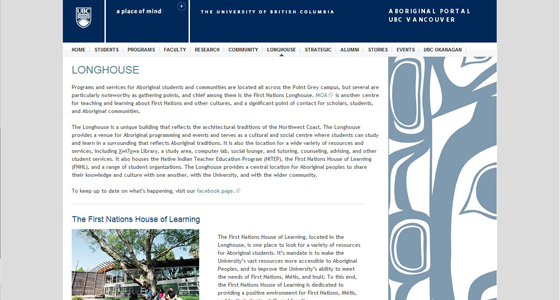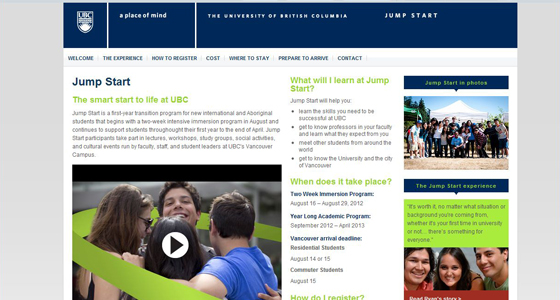 At a recent Classroom Climate: Aboriginal Initiatives workshop, entitled Supporting Aboriginal Students, discussions arose around how to best orient Aboriginal students to UBC. With a dramatic change in Aboriginal student demographics, UBC needs to ensure that it has the proper support systems in place to serve the needs of this group of students. Not too long ago, most newly admitted Aboriginal peoples came to UBC as mature students. Now, newly admitted Aboriginal students enter UBC between the ages of eighteen and twenty. Half of all newly admitted Aboriginal students come to UBC straight from high school, while the other half come from transfer colleges and universities. This younger demographic has different needs from previous generations, and the workshop looked at some of the different support systems that are being put in place at UBC. The workshop also looked at ways to better connect Aboriginal students to the UBC community.
At a recent Classroom Climate: Aboriginal Initiatives workshop, entitled Supporting Aboriginal Students, discussions arose around how to best orient Aboriginal students to UBC. With a dramatic change in Aboriginal student demographics, UBC needs to ensure that it has the proper support systems in place to serve the needs of this group of students. Not too long ago, most newly admitted Aboriginal peoples came to UBC as mature students. Now, newly admitted Aboriginal students enter UBC between the ages of eighteen and twenty. Half of all newly admitted Aboriginal students come to UBC straight from high school, while the other half come from transfer colleges and universities. This younger demographic has different needs from previous generations, and the workshop looked at some of the different support systems that are being put in place at UBC. The workshop also looked at ways to better connect Aboriginal students to the UBC community.
Give Better Student Support by Asking Questions
Amy Perreault, Coordinator of Aboriginal Initiatives at CTLT, began the workshop with a personal story. A few years ago, when Amy was working as an Aboriginal Students Advisor, a student came in to see her about an eviction notice she had gotten from UBC Housing. The student explained to Amy that her loans were on hold, and that she could not pay UBC Housing until a later date. To ensure the student’s well-being, Amy asked the student some follow-up questions. Amy asked the student what kind of support she was getting on campus, and how she was doing academically. Through this experience, Amy realized that students will not tell you what their lives are like unless you ask them. Amy also realized that it is difficult to understand student demographics without directly interacting with the student population. A friend once advised her, “if you want to know what the students lives are like, you need to go to where the students are.”
Changes in Aboriginal Student Demographics
Rick Ouellet, Student and Community Development Officer at the First Nations House of Learning, works towards improving the relationship between Aboriginal communities and UBC. Rick pointed out that UBC has made great progress in terms of understanding its incoming student demographics. Until recently, UBC did not have data on incoming student demographics. Rick explained that the new data shows changes in Aboriginal student demographics. In previous years, most of the Aboriginal students coming to UBC were mature students. More recently, however, more Aboriginal students are coming straight from high school or small colleges and universities, and are between eighteen to twenty years old.
Rick noted that UBC had previously built support systems for Aboriginal students based on the idea that most students were “mature students.” However, with a growing number of young Aboriginal students, UBC is looking for new ways to cater to and build resources for this group of students. There are currently just under 1000 undergraduate Aboriginal students at UBC, and 650 are self-identified. Rick recognizes that UBC is not quite there in terms of reaching its long term goals for supporting Aboriginal students, but that it has made progress. Many accomplishments have been made in terms of providing better services for this younger Aboriginal student population.
Aboriginal Student Services and Resources at UBC
The First Nations Longhouse
 The creation of the First Nations Longhouse, Rick stated, was a success for the integration of Aboriginal students into the UBC community. The Longhouse offers Aboriginal students a variety of services, allowing them to socialize, study, and seek help. Aboriginal students are introduced to the Longhouse through an optional first-year orientation at UBC: the Jump Start Program. The idea behind creating the Longhouse was to re-create a village-like space, where Aboriginal students would not “feel so alienated.” Rick stated that the space has been crucial for the integration of Aboriginal students into the UBC community, especially when some students have reported that some of their classrooms “had more people than their entire village.”
The creation of the First Nations Longhouse, Rick stated, was a success for the integration of Aboriginal students into the UBC community. The Longhouse offers Aboriginal students a variety of services, allowing them to socialize, study, and seek help. Aboriginal students are introduced to the Longhouse through an optional first-year orientation at UBC: the Jump Start Program. The idea behind creating the Longhouse was to re-create a village-like space, where Aboriginal students would not “feel so alienated.” Rick stated that the space has been crucial for the integration of Aboriginal students into the UBC community, especially when some students have reported that some of their classrooms “had more people than their entire village.”
Cree Language courses with UNYA (Urban Native Youth Association)
In partnership with UBC, the Urban Native Youth Association offers Cree language courses at no cost. The Cree language courses involve both UBC and Aboriginal community students. The program was designed in order to help maintain the Cree language and, so far, it has been a success. Rick stated that the Cree language courses encourage Cree communities to keep their language alive, while it allows UBC to create strong ties with the Cree families and communities.
Summer Math Program (Pacific Institute for the Mathematical Sciences)
The Summer Math Program with the Pacific Institute for the Mathematical Sciences involves about 20 Aboriginal high school students. The program facilitates the success of Aboriginal high school students; they are able to gain relevant work experience, and are able to interact with UBC faculty members. Furthermore, Rick stated that the Summer Math Program is a great way for Aboriginal high school students to create ties with UBC, and will hopefully encourage the students to apply in the future.
Changing the Perception of Higher Education Amongst Aboriginal Communities
Next, Rick discussed the areas that UBC still has to work on in order to encourage even more Aboriginal peoples to come study at UBC. First, UBC needs to work on changing the perception of the university amongst Aboriginal communities. For example, Rick mentioned that some Aboriginal communities still associate a university, as an institution, with the colonial past. The perception of the university as a colonial enterprise needs to be changed. Rick also mentioned that some Aboriginal peoples are afraid that their members will move away and never return to the community if they go to university. It is important, Amy noted, to create programs that will build and maintain a strong relationship between Aboriginal communities and UBC. Amy stated that “we want to avoid that awkward one time exchange” and instead build “long lasting ties.” Furthermore, creating long lasting relationships with Aboriginal communities could ease the stress of some first generation university students. Amy stated that this is especially important when 75% of Aboriginal students are first generation university students.
Group Discussions
The Connection Between Aboriginal Students and International Students
 In order to facilitate the discussion amongst workshop attendees, Amy broke the attendees into three groups. She then brought up two discussion topics: what do changing demographics mean to your role at the university and what are some positive changes that have been made?
In order to facilitate the discussion amongst workshop attendees, Amy broke the attendees into three groups. She then brought up two discussion topics: what do changing demographics mean to your role at the university and what are some positive changes that have been made?
The first group explored what the changing demographics meant holistically. The group discussed the impact of incoming international students, and the importance of educating these students about the histories of Aboriginal peoples. Many international students come to UBC without any knowledge of the history of Aboriginal peoples. With the growing number of Aboriginal students at UBC, and the growing number of international students, the group thought that interaction between the two groups of students should be encouraged. A suggestion was to create more connections between the International House and the Longhouse. Such considerations and ideas seem to be already developing. For example, the integration of Aboriginal students into the Jump Start Program has facilitated the interactions between Aboriginal students and international students. Furthermore, it has been a success in helping to integrate first year Aboriginal students into UBC.
Making the Transition Easier
The second group thought that more could be done to help understand the different services that the younger Aboriginal demographic requires. The third group discussed programs that could be put into place to encourage Aboriginal students to feel more comfortable with the transition from high school to university. One group member discussed her personal experience of coming from a small community, and feeling that she could not connect back with the community once she was at UBC. She described how, once at UBC, no one asked where she came from or how she was going to connect and give back to her own community. The third group suggested that a program that would help students connect back to their communities could help facilitate the transition between small community life and UBC. Such a program may also make the university feel less threatening to some Aboriginal communities.
With younger Aboriginal student demographics, the group also discussed how a transition program should be put in place between high school and university. The group cited how the University of Victoria and some universities in Australia have such programs already in place. The University of Victoria invites Aboriginal high school students to spend a night at the university’s student residence. The students also get a chance to meet professors from the University of Victoria, and a chance to tour the campus.
In addition to trying to better accommodate current students, attendees felt that more programs needed to be put in place that would encourage Aboriginal high school or college students to apply to UBC. One group member did note that a college-to-university transfer program for Aboriginal students was being developed, and this program will hopefully encourage Aboriginal students to apply to UBC.
With the workshop coming to an end, the group members left with a sense that much progress has been made to better accommodate current Aboriginal students, and that there is much more to come in the near future.
Comments are closed, but trackbacks and pingbacks are open.